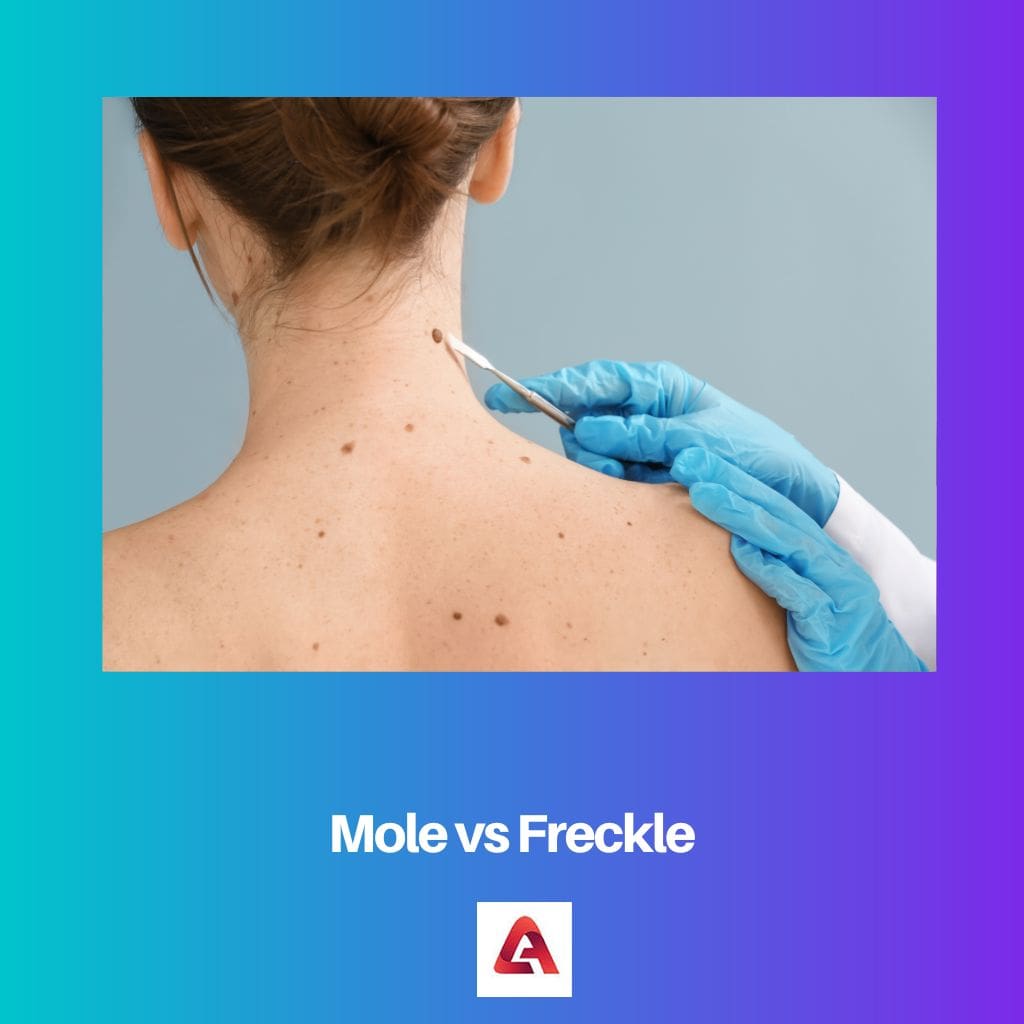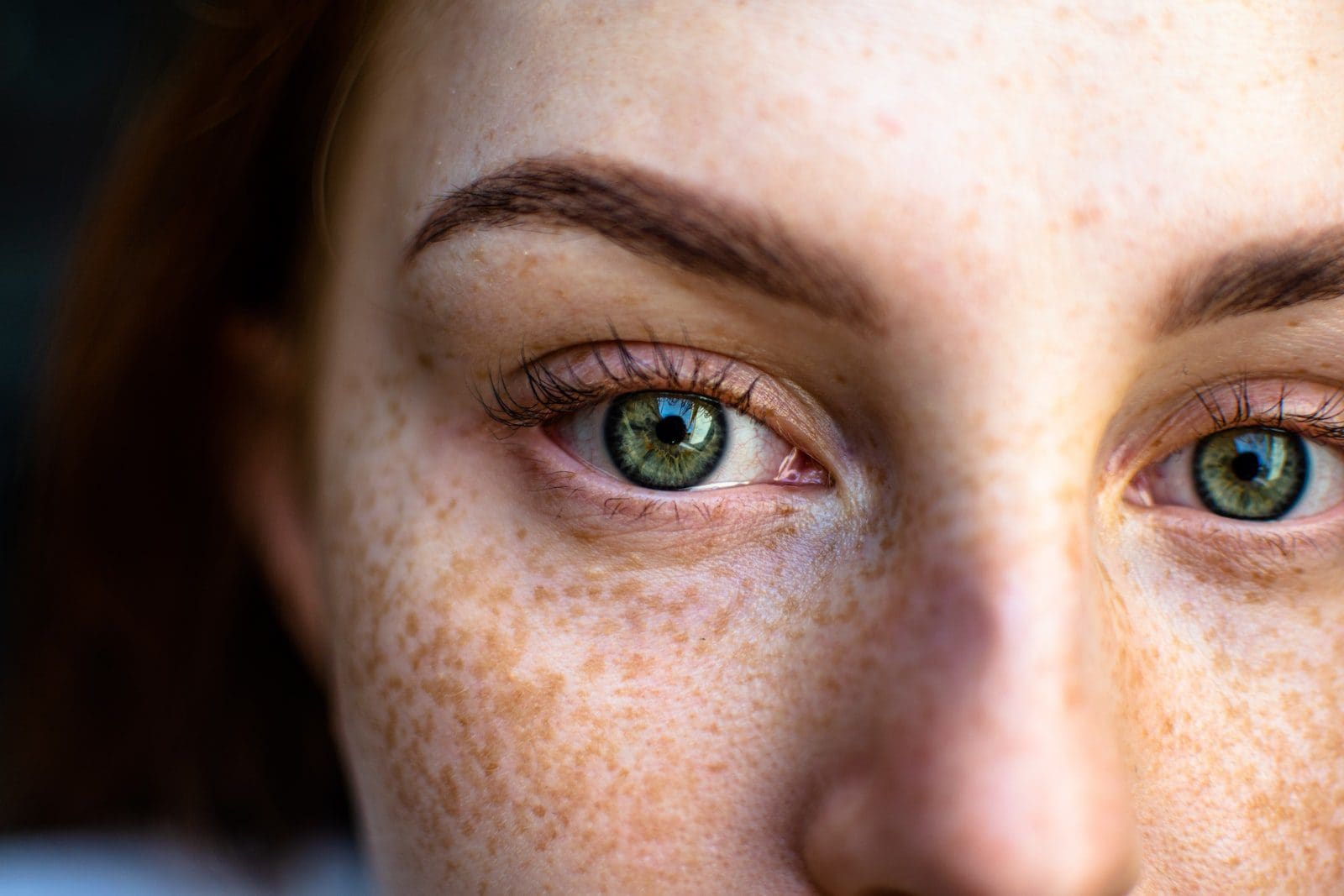We all have different skin and different skin types. It mainly depends on the environment and the locality where we live.
Some people have some feature of marks on their skin, especially on their faces, that are not found in many. A great example of such marks can be mole and freckle; both of them are similar-looking pigmented marks on some people.
Both of them can easily be seen on the skin. Due to their similarities, it is difficult for some people to distinguish between both of them.
Key Takeaways
- Moles have raised skin growths containing melanocytes, while freckles are flat spots with increased melanin production.
- Moles can be present at birth or develop later in life, whereas freckles are a result of sun exposure and genetic factors.
- Freckles may fade over time, especially with reduced sun exposure, while moles remain unchanged or change slowly.
Mole vs Freckle
Moles may be flat or raised, but Freckles are flat. Moles are either black, brown, pink, or blue, but Freckles are brown in colour. Moles can turn into Cancer, while Freckles can’t. Moles go deeper in skin layers compared to Freckles. Moles don’t occur due to sun exposure, but freckles do.

A mole is a dark or pigmented spot on the skin that is slightly above the skin level and goes deeper into layers of skin. They are not always harmful, but in a few cases can cause skin cause.
They can easily be seen on even dark skin tones. They can be found in every second person and do not affect the sunlight or weather conditions.
They can be birthmarks or may appear later in life. In most cases, they are genetics.
Freckles are small tan-brown or pigmented spots on the face. They are found in the face, mostly not on any other part.
They have a direct connection with sunlight exposure. They are seen on most people with fair skin tone as in deeper skin tone they get hidden in the complexion.
They cannot be a birthmark but appear later on and can also disappear at any time. They are not seen by many people.
Comparison Table
| Parameters of Comparison | Mole | Freckle |
|---|---|---|
| Turn cancerous | They can be cancerous. | They are not harmful. |
| Skin type | Deeper skin | Lighter skin |
| Common | More common | Less common |
| Appear | Early age | Later years |
| Associated with | Genetics | Directly sun exposure |
What is a Mole?
They are small pigmented spots on the body. The color of them can vary; it can be pink, tan, black, or red.
They also differ in size from person to person. When skin cells grow in clumps on top of each other, they result in developing moles in that area.
Hair can also grow through them. They appear in later years of life and go deeper into skin layers.
They can also be grown in the womb only, and an average adult has around 40 moles in his body that may go away but not in most cases. By the age of 20, moles start appearing on the body completely.
Although mole does not cause any harm (they may cause skin cancer but rarely), some people remove them from certain revealing areas such as the face as they don’t prefer spots on their faces.
The techniques used for removing them depend on the size and type of the mole. But most commonly, they are burned with fire, after which they leave a red spot or a day or two, but later they may or may not grow back.
But if a person has lots of moles, he should get checked with his moles are not cancerous.

What is a Freckle?
Freckles are spots that can be light and dark on the face. They are caused by direct exposure to the sunlight but appear mostly during winter, and people with pale skin have more freckles than others.
They don’t go deeper in the skin and appear after birth mostly. Depending on the skin type and weather, they can go away at any time.
They are two types; one is brown in color and most common, and the other that is called liver or age spots.
Natural freckles are those children get from their families or parents. Wearing proper sunscreen with SPF 50 can also reduce the cause of freckles in some people.
Other methods of removing or fading them include bleaching or fading creams, laser treatment, photo facials, chemical peels, and retinoids, cryosurgery.
But the treatment of them is not essential as they don’t cause any irritation or pain on the skin, but some people do not like freckles on their face and use makeup and other products for hiding and treating them.
But after treating them, there is a chance they will come back again on the skin.

Main Differences Between a Mole and a Freckle
- Moles can be harmful to the body, while freckles can never cause any harm. For example, studies have found that mole can be cancerous, but freckle does not cause cancer or any other disease or reaction.
- Both moles and freckles are situated on skin layers, but when compared, moles are deeper in skin layers, while freckles do not. Freckled are on the first or uppermost layer of the skin.
- When compared in terms of their type and size, freckles are flat and stick plainly with the skin, whereas mole is more raised on the skin and can be easily felt by touch.
- Both of them can be found easily, but moles are way more common in comparison to freckles, which mostly happen to pale skin people.
- Freckles are found in people with fair or white skin. The reason could be in these people, and freckles can be easily noticed or seen, whereas moles can be found in people with different tones, including darker tones.
- Moles appear earlier. Even some people have them from birth, but freckles grow later in comparison.
- Moles cannot disappear on their own. Once they take place, they can only disappear with the help of surgery, whereas freckles can disappear even if they are throughout their life.
- Freckles are more associated with direct exposure to sunlight, while a mole is not associated with sunlight.

- https://www.sciencedirect.com/science/article/pii/0190962295903380
- https://www.sciencedirect.com/science/article/pii/S1877050915001441
- https://jamanetwork.com/journals/jamadermatology/article-abstract/551845

The comparison table provided in the post is a great way to understand the differences between moles and freckles. It’s essential to be aware of the signs of skin cancer associated with moles.
I agree, being informed about the characteristics of moles and freckles is important for maintaining skin health.
Understanding the distinctions between moles and freckles is vital for recognizing potential skin issues. The information in the post is enlightening and helpful for establishing skin health priorities.
Absolutely, the content offers valuable insights into these skin features, enabling better decision-making for maintaining skin well-being.
I share the same sentiments, it’s vital to be well-informed about moles and freckles for skin care.
The detailed information about moles and freckles in the post provides valuable awareness about the two skin conditions. The potential risks associated with moles are noteworthy for skin health.
I completely agree with your viewpoint, the educational content is beneficial for everyone.
Indeed, the post educates readers about the characteristics and risks of moles and freckles, which is significant for skin care.
The post provides comprehensive information about moles and freckles, including their causes, characteristics, and possible treatments for freckles. This will benefit readers looking to gain knowledge about skin-related issues.
Absolutely, knowing how to identify and manage moles and freckles is crucial for skin care.
The comparison of moles and freckles in the post highlights the differences in their visual appearance and potential risks. This aids in understanding more about these skin features.
Well said, it’s important for individuals to recognize these differences for skin care awareness.
The post delivers detailed and informative content on moles and freckles, offering understanding of their distinct characteristics. This is beneficial for individuals seeking knowledge about skin conditions.
Absolutely, the educational value provided in the post enhances awareness about moles and freckles for skin health management.
The detailed description of moles and freckles in this post is very helpful. It’s crucial to understand the appearance, nature, and potential risks associated with these skin features.
I couldn’t agree more, this information can help people make informed decisions about their skin health.
Moles and freckles are both common skin features caused by different factors such as genetics and sun exposure. Moles can be harmful and need to be checked for cancer, whereas freckles can be reduced or even disappear over time.
Interesting insights, I appreciate the useful information.
Thank you for the informative comment, I totally agree with your points.
The post presents detailed information about moles and freckles, facilitating understanding of their characteristics and potential risks. Skin care awareness is enhanced through such valuable content.
I couldn’t agree more, this information benefits individuals aiming to optimize their skin health.
Definitely, the post serves as an educational resource for enhancing knowledge about moles and freckles.
The comprehensive comparison between moles and freckles in the post furnishes valuable insights into these skin features. The detail about the signs of skin cancer associated with moles is particularly useful.
Agreed, understanding the differences between these skin conditions is essential for maintaining skin well-being.
Indeed, awareness of the nature of moles and freckles contributes to effective skin health management.